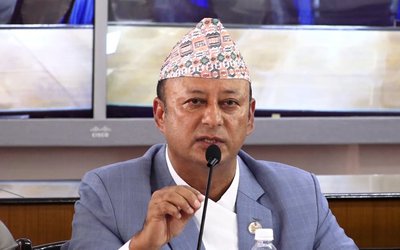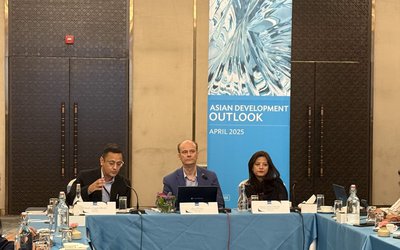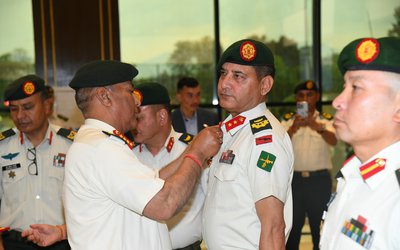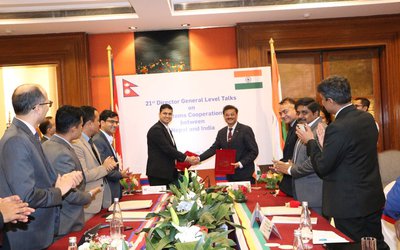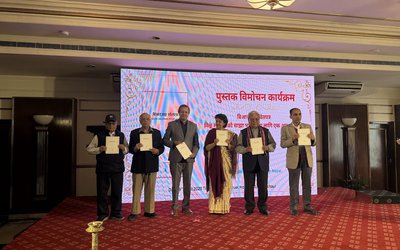
With new upsurge and second wave of COVID-19, the world’s economy is facing an uncertain scenario. Nepal is no exception. As countries around the world have been announcing the stimulus packages to maintain the economic growth, Nepal is yet to make such announcements to provide incentives and relief to the industries.
Despite sluggish economic activities, there is a good sign for Nepal, as well. The World Bank says that Nepal’s GDP is projected to grow by 2.7 percent in the fiscal year 2021-22 and recover to 5.1 percent by 2023.
After contracting for the first time in 40 years in FY2020, Nepal’s economy is projected to grow by 2.7 percent in FY2021, driven primarily by services as social distancing measures continue to be relaxed and vaccines rolled out for priority populations. Agriculture is also expected to perform well, on the back of recent favorable monsoons. Exports could be a powerful platform to boost post-pandemic recovery and enable Nepal to transition towards green, resilient, and inclusive development, states the World Bank’s latest Nepal Development Update.
Upbeat by the World Bank’s recent report, Finance Minister Bishnu Poudel has already started the formulation of the budget giving focus to the areas which support Nepal’s growth.
Economy projected to grow by 2.7 percent in FY2021 due to easing of social distancing and good monsoons The update notes that the tourism sector may not fully recover without reforms to readjust to a post-COVID-19 tourism market. The current account deficit is expected to widen marginally in FY2021 to 1.2 percent of GDP as imports and remittances recover modestly while exports remain tepid. Revenue performance is also expected to remain weak. This coupled with additional spending on economic relief measures, vaccinations, and the resumption of project implementation should contribute to increase the fiscal deficit close to 7 percent of GDP in FY2021.
While the government has outlined a program to address the impacts of COVID-19 to mitigate the attendant risks to the outlook, the Nepal Development Update highlights the importance of improving export competitiveness for a resilient economic recovery.
“Nepal’s untapped export potential is estimated to be around US$9.2 billion, 12 times its actual annual merchandise exports,” said Dr. Kene Ezemenari, World Bank Senior Economist and lead author of the update. “This export potential represents an opportunity to create an estimated 220,000 new jobs, with significant implications for productivity growth. Realizing that potential is not unrealistic in the medium term.”
The report outlines six key priorities for Nepal to achieve its export potential. These include reforming the tourism sector for a quick and resilient recovery; simplifying and streamlining processes to attract more FDI; modernizing export promotion and upgrading exporters’ capabilities; reducing trade costs; investing in phytosantary and quality control-related infrastructure; and boosting digital trade and e-commerce for more opportunities linked to global value chains.
“Nepal's economy is on the path to recovery amid the severe impacts of the global COVID-19 pandemic which affected people lives and livelihoods, and businesses,” stated Honorable Finance Minister, Bishnu Prasad Paudel. “The recommendations that can help harness the potential of exports in supporting Nepal’s economic recovery are in line with the government’s policies and priorities. The Government of Nepal is working together with development partners and the private sector on a green, resilient and inclusive development agenda to help Nepal build back better and greener from the pandemic.”
The Government of Nepal’s relief, restructuring and resilience plan addresses the pandemic’s impacts from the immediate to the long term with a focus on a green, resilient, inclusive recovery. The first stage of the plan is focused on relief support to businesses and households most affected by COVID-19. In the restructuring phase or medium-term, the focus is on recovery through investments to promote and create green jobs that sustain the country’s natural capital base. In the long term, the plan focuses on sustainability and resilience for inclusive growth.
“We welcome the government’s planned reforms to support Nepal’s green, resilient, and inclusive development. This will be the foundation for Nepal to emerge stronger from the crisis,” stated Faris Hadad-Zervos, World Bank Country Director for Maldives, Nepal, and Sri Lanka. “We look forward to continued collaboration with the government and development partners in this effort, particularly on investments that harness Nepal’s export potential to support a sustainable and resilient recovery.”
“The Bank’s report encourages us to work for recovery of our economy. Given the last six months’ data, what I can say is that Nepal is in the right track to achieve almost 3 percent GDP growth in the coming fiscal year,” said minister Poudel.
The outlook for Bangladesh, Nepal, and Pakistan has also been revised upward, supported by better than expected remittance inflows: Bangladesh’s gross domestic product (GDP) is expected to increase by 3.6 percent in 2021; Nepal’s GDP is projected to grow by 2.7 percent in the fiscal year 2021-22 and recover to 5.1 percent by 2023; Pakistan’s growth is expected to reach 1.3 percent in 2021, slightly above previous projections.
Prospects of an economic rebound in South Asia are firming up as growth is set to increase by 7.2 percent in 2021 and 4.4 percent in 2022, climbing from historic lows in 2020 and putting the region on a path to recovery.
But growth is uneven and economic activity well below pre-COVID-19 estimates, as many businesses need to make up for lost revenue and millions of workers, most of them in the informal sector, still reel from job losses, falling incomes, worsening inequalities, and human capital deficits, says the World Bank in its twice-a-year-regional update.
The latest South Asia Economic Focus, South Asia Vaccinates, shows that the region is set to regain its historical growth rate by 2022. Electricity consumption and mobility data is a clear indication of recovering economic activity. India, which comprises the bulk of the region’s economy, is expected to grow more than 10 percent in the fiscal year 2021-22—a substantial upward revision of 4.7 percentage points from January 2021 forecasts.
“We are encouraged to see clear signs of an economic rebound in South Asia, but the pandemic is not yet under control and the recovery remains fragile, calling for vigilance,” said Hartwig Schafer, World Bank Vice President for the South Asia Region. “Going forward, South Asian countries need to ramp up their vaccination programs and invest their scarce resources wisely to set a foundation for a more inclusive and resilient future.”
While laying bare South Asia’s deep-seated inequalities and vulnerabilities, the pandemic provides an opportunity to chart a path toward a more equitable and robust recovery. To that end, the report recommends that governments develop universal social insurance to protect informal workers, increase regional cooperation, and lift customs restrictions on key staples to prevent sudden spikes in food prices.
- BIMSTEC SUMMIT: Nepal’s Stand
- Apr 11, 2025
- IME GROUP: Expands Into Paper Industry
- Mar 24, 2025
- CPN UML: Instigated By India
- Mar 23, 2025
- ADB’S CHIEF ECONOMIST: Nepal Reduces Poverty
- Mar 11, 2025
- FM DR. DEUBA: A Successful Visit
- Mar 11, 2025



